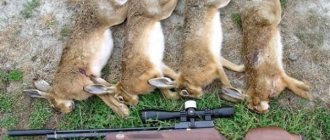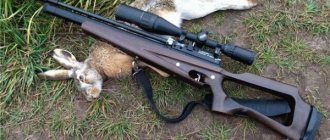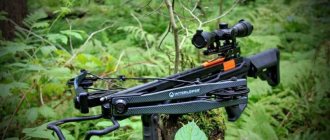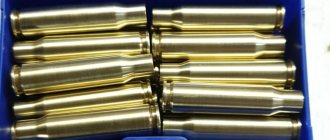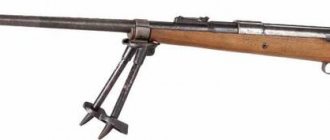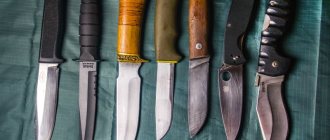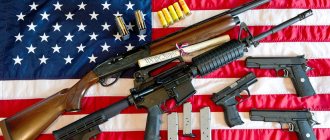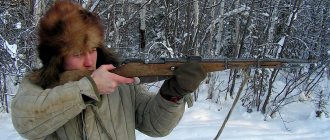Spearfishing enthusiasts are increasingly asking the question: which is better, a crossbow or a pneumatic gun? To understand this, it is necessary to take into account not only all the advantages and disadvantages of both types of weapons, but also pay attention to the type and form of hunting. After all, underwater fishing can be sea and freshwater, which significantly differs in power, weight and total amount of production. This means that the weapon for hunting must be appropriate.
Hunting in the deep sea is much more enjoyable because the water is clearer and the area of activity is wider. It is the latter factor that is decisive in choosing a weapon, because the speed of movement of a fish when meeting a hunter is not as important as the huge underwater space for its escape. Therefore, when sea spearfishing, it is better to use a crossbow.
Hunting in freshwater bodies requires poor visibility and fairly shallow depths. Due to the murky and opaque water, the hunter will need quick reaction time and a small weapon capable of reaching the prey from a short distance. An air gun is better suited for these purposes.
What pneumatic weapons are considered hunting?
MP-513M, one of the most common hunting rifles in the Russian Federation
First, let's find out which air gun can be considered a hunting weapon. The “Law on Weapons” states that a weapon whose muzzle energy exceeds 7.5 J is considered a hunting weapon. A special permit will be required for it.
Pneumatics with a caliber of up to 4.5 mm and a power of 3 to 7.5 J are considered sports, so you do not need a license to use them, but you cannot hunt with such a weapon. If you try, you can use such a weapon to shoot a wild bird - for example, a duck, but only by hitting some vital organ. Otherwise, you simply injure the animal.
Buy GAMO CFX air rifle
Well, as for pneumatics with a power of up to 3 J, then in principle it is not considered a weapon, and it is impossible to shoot game with it - at most, to wound it, however, despite this, you should still handle such a weapon carefully.
So, if your goal is to purchase a weapon for hunting, then pay attention to pneumatics with a power ranging from 7.5 to 25 J. In order to use such a weapon, you will need not only a special permit, but also a hunting license - this document will confirm the fact that you have the right to hunt. Immediately after purchase, your purchase will need to be registered at the police station at your place of residence.
Subjective indicators of the power of bows, crossbows and pneumatics
If we are not talking about hunting, but about entertaining “shooting games” for a bet, then I can say the following. A magnum-class spring-piston rifle sews a half-inch board right through, and splits some (apparently with defects). “Supermagnum” is capable of making holes in commercial rolled metal - mind you, with soft lead bullets. “Overclocked” rifles with modified ammunition make this easy. A blank fence made of corrugated sheets for pneumatics is not an obstacle - keep this in mind. A standard 95 lbs/43 kg compound crossbow at 30 meters will typically split boards. Moreover, the arrow also stabs not too thick (up to 10 centimeters) trees, although it gets stuck in a split. She doesn’t notice corrugated sheeting and similar materials at all, losing, however, her plumage. In its hunting version, fired from a crossbow with reinforced shoulders, it destroys everything that gets in its way, including the rather frail scapula of a large animal. A 40-pound recurve bow is much more loyal to various obstacles, mainly arrows. But a legal “block gun” with 60 Lbs (27 kgf) hits no worse than a forbidden powerful hunting crossbow.
What about bow/crossbow hunting?
More recently, in the middle of last year, amendments were made to the law “On Weapons” regarding hunting using a bow or crossbow. Many people misinterpreted these changes and thought that it was now officially legal to hunt with a bow/crossbow. Let's figure out what amendments were made.
First of all, bows and crossbows officially became weapons. This is stated in the relevant paragraph of the law:
“Throwing small arms are a throwing weapon, which is a mechanical device that converts the deformation energy of elastic elements into the directed movement (throwing) of a projectile to hit a target located at a distance.”
But fortunately for many fans of archery hunting, this does not apply to all products: if your weapon is a bow with a power lower than 27 kgf or a crossbow weaker than 43 kgf, registration is not required. This is stated in the following passage:
“Hunting small arms that do not have mechanisms for fixing elastic elements in a tense state (bow) and the arc force of which is more than 27 kgf, or which have a mechanism for fixing elastic elements in a tense state (crossbow) and the force of the arc (arcs) of which is more than 43 kgf ( hereinafter referred to as hunting throwing small arms).”
This news may bring joy to shooters, as previously powerful bows and crossbows were illegal and did not have the appropriate legal status. Now such weapons are allowed to be purchased, but with certain nuances. How to buy a powerful bow or crossbow
The sale of small arms with a power higher than that mentioned in the previous paragraph is limited. The law states that to purchase such products, a license, like for pneumatics, will not be required, but upon purchase you will have to present a hunting license or appropriate permit.
From this we can conclude that small arms are available for purchase only to those hunters who already have, for example, a gun and a permit to store it. This creates inconvenience for those planning a purchase.
In addition, after purchasing a crossbow or bow, you will need to register it with the Russian Guard within two weeks from the date of purchase. Also, if you are the owner of a crossbow or bow, at least once every five months you will need to provide a special permit, which states that you are allowed to use these types of weapons, as well as a certificate confirming the absence of narcotic substances and their products in your body decay. All certificates are provided to the Federal Service of the National Guard Troops of the Russian Federation.
Crossbow or pneumatic spearfishing?
Choosing a crossbow gun for underwater hunting requires that several factors be taken into account. If you compare a crossbow with an air gun, the crossbow is much simpler, it has fewer parts and is much easier to maintain and repair. A crossbow for underwater hunting is the very first thing that appeared among the peoples of Oceania when they hunted fish, which was the main source of food for them. Of course, the first and primitive crossbows were a straight stick with stretched whalebone ropes, and their modern analogues are much more effective, technologically advanced and durable.
In sea hunting conditions, a crossbow is preferable to an air gun. Excellent visibility in sea water, the need for a more powerful shot when hunting large sea fish, the absence of snags and grass - all this makes it possible to use a crossbow more effectively with a long barrel length. The long barrel length gives greater power and accuracy of the harpoon's launch.
Pneumatic spearguns for spearfishing provide advantages in river water, low water transparency, the presence of grass, reeds, snags - all this requires a small-sized gun, with the maximum possible force of the harpoon for such a length.
Advantages of air guns for spearfishing:
- good power and fighting strength with a small size (from 40 cm)
- presence of firing force adjustment on a loaded gun - if equipped with a firing force regulator
- large selection of harpoons and their standardization between manufacturers
- low weight and length allow you to gain an advantage when maneuvering underwater
- long retention of charge force due to the reuse of compressed air in the gun
Disadvantages of air guns for spearfishing:
- Shot accuracy is less compared to crossbows for underwater hunting
- high impact force and short barrel length require good aiming skills, which are developed over time
- quite a lot of force when activating the trigger mechanism, not always convenient in water
- greater noise when fired than a crossbow - lower percentage of hits on fish
- the greater the depth, the less force of the shot
- less safe process of loading a gun - you need to use a special tip when pushing and fixing the harpoon into the barrel at the time of loading
- the use of moving parts in the mechanism means less reliability and the possibility of failure, especially when the compressed air container depressurizes.
Advantages of crossbows for spearfishing:
- ease of use, ease of aiming
- there is no effect of the barrel twitching and tossing when firing
- the shot is sharp and silent
- loading the gun is simple - safer and more reliable
- the trigger mechanism is lighter when the trigger is pulled and therefore more responsive
- high shot accuracy due to the long barrel length
Disadvantages of crossbows for spearfishing:
- longer length than air guns (pneumatic) for spearfishing
- drop in shot power as the water temperature drops (the elasticity of the tension bands decreases)
- Over time, elastic bands lose their original qualities, stretch out and need to be replaced
- there is no possibility of adjusting the power-strength of the fight
How to choose a speargun for spearfishing? Is a pneumatic gun or crossbow preferable for a beginner?
First, you need to base it on where you are hunting. In Russia, most rivers and lakes are reservoirs with water transparency of 1-2 meters. Our water is freshwater, the depth in most rivers does not exceed 3-8 meters. Hunting in our rivers and lakes requires thick wetsuits; there are requirements for masks or fins, but they are mostly individual. In this case, the weapon needs to be small in size, easy to maneuver underwater, and have sufficient shot power. For this reason, for a novice underwater hunter in our country and our water bodies, pneumatic underwater guns are preferable .
Sea spearfishing, as already written above, means clean water and large fish with good armor, which you need, if you don’t try to pierce, then hit exactly the place where it is more vulnerable - for this you need high accuracy of the shot. When sea hunting, the underwater hunter's equipment changes to a thin wetsuit, sometimes even short (sleeveless and knee-length), denser sea water requires more effort to dive and creates more pressure - the mask should be of little volume, the fins are generally long. A crossbow for sea hunting is needed with a long barrel; their main feature is the ability to hit fish at a great distance (the transparency of sea water allows you to hit a target at a distance of 3-6 meters) . For this reason, crossbows for sea hunting are made with a barrel length of up to 1.5 - 2 meters. With such a long trunk, it is no longer possible to climb in reeds, crevices, and between snags.
Now in stores there are options for pneumatic guns and crossbows for every taste. There are even crossbows with a barrel length of 40 or 50 cm, the price of which starts from 2000-3000 thousand rubles. There are varieties of pneumatic guns - hydropneumatic, their use is acceptable, but for a beginner it is better to opt for brands from trusted manufacturers. Hydropneumatic guns for spearfishing are more demanding to operate and more difficult to manufacture and repair. Of course, they provide greater shot force than pneumatic ones, but their design is not standardized and most are produced by professional amateurs or in single copies.
As a result, we can say that if you are a beginner underwater hunter and live in Russia, then you should choose your first speargun for spearfishing from the line of inexpensive pneumatic guns. As a backup or additional option, you can purchase a crossbow with a short barrel length - 50-79 cm.
If you have questions about spearfishing, contact the Batiur store. We are always in touch and ready to help.
What is prohibited for bowhunters
For hunters using crossbows and bows, there are certain prohibitions that must be observed. In particular, it is prohibited:
- hunt animals within 200 meters of residential premises;
- when hunting with a bow and crossbow in the evening, the use of night vision devices and thermal imagers is prohibited;
- if there is a collective hunt, the use of small arms is prohibited;
- Hunting with bows or crossbows is prohibited at night.
How to choose a speargun according to hunting conditions?
Due to the geography of Russia, the words spearfishing and freshwater spearfishing are synonymous for many. Therefore, the vast majority of underwater hunters come into hunting precisely as freshwater hunters and remain so.
A person who lives at sea or becomes interested in spearfishing during his vacation at sea will most likely strive to hunt specifically at sea. But he will definitely try freshwater hunting.
Sea hunting usually involves clear water and great depths. Accordingly, sea hunting involves the use of thin wetsuits, low-volume masks, only long hunting fins and long-range (long) crossbows. Their main feature is the ability to hit fish from a long distance, that is, from 3 to 5 meters. For this purpose, guns for sea hunting are made long, up to one and a half meters long. Guns of this length cannot be used in poor visibility, when hunting in reeds, underwater bushes and rubble of underwater snags, in stones and crevices.
Freshwater hunting means low transparency and shallow depths. In this case, thick wetsuits are used; there are no special requirements for masks and fins. The weapon requires small dimensions, high maneuverability, and due to the fact that shooting is carried out from short distances, greater combat accuracy is not required. Therefore, pneumatic underwater guns, today, are most suitable for hunting in fresh water bodies.
Even if hunters go to a reservoir in a group, then directly in the water, while in a state of hunting, the hunter will always be alone. Accordingly, the hunter must have equipment that gives him a greater degree of autonomy and reliability. It is for this reason that, despite all the theoretical advantages in efficiency of various hydropneumatic, pneumatic vacuum and other small-scale guns, the long-known “Italian pneumatics” are produced and sold in tens of thousands. The main advantages of serial Italian air guns are their reliability and repeatability of properties (quality guarantee and sufficient functionality).
People for whom spearfishing in various forms is a way of life often own several spearguns and equipment for different conditions.
Pneumatic or crossbow WHAT IS BETTER?
ONLY arguments for and against. pneumatic or crossbow!
I'm racking my brains over the choice! money doesn't really matter! Our St. Petersburg reservoirs, well, maybe even the Volga!
#2 Message Added: 03/23/2008 13:01 Message title:
#3 Message Added: 03/23/2008 13:41 Message title:
#4 Message Added: 23-03-2008 14:01 Message title:
#5 Message Added: 03/23/2008 15:57 Message title:
#6 Message Added: 03/23/2008 16:23 Message title:
#7 Message Added: 03/23/2008 17:12 Message title:
#8 Message Added: 03/23/2008 19:04 Message title:
#9 Message Added: 03/23/2008 19:18 Message title:
#10 Message Added: 03/23/2008 19:30 Message title:
#11 Message Added: 03/23/2008 20:02 Message title:
#12 Message Added: 03/23/2008 21:59 Message title:
Considering that “our” factory guns are no good without modification, and there are no big problems with money, the Belarusian Kayuk or short Italian pneumatic Cressy SL Star or Mares Cyrano 40-55 cm will be suitable for your conditions. But for the Volga, something more powerful. 60-70 cm pneumatic or 75 crossbow with rods of 19 mm or more.
And the laughter is fair. What question. You haven’t seen hundred-page discussions on this topic in the forums. In some places they are still going. It seems to be over here. It's like Intel vs AMD, Radeon vs GeForce, Alien vs Predator. The dispute is not about hunting conditions, but about a matter of taste.
#13 Message Added: 03/23/2008 22:13 Message title:
#14 Message Added: 03/23/2008 22:52 Message title:
#15 Message Added: 03/23/2008 23:03 Message title:
So, as for the weak, I have already apologized! Andre, Vlanik and Treng quarrel!quarrel!quarrel!quarrel!quarrel!quarrel!quarrel!quarrel!quarrel!quarrel!quarrel!quarrel! couldn't stand it because I regard banter as childish antics (back from the forums of extreme sports, punks have gone crazy), although I myself am certainly not devoid of a sense of humor. As for searching the forum for a question that interests me, read again above! I was looking specifically for the pros and cons of this or that type of weapon. Well, imagine you wanted to go to the store and there was a cruiser and a patrol and? what is the choice? I don’t think that you will rely on the choice of the seller, but turn to experts, that’s all.
z.y. I am grateful to everyone who wrote above - the picture is more than clear.
#16 Message Added: 03/24/2008 09:21 Message title:
A pneumatic 50 cm is optimal (if imported), reliable, maneuverable, for most fish in central Russia it will certainly be suitable, original pneumatics can be taken from 40 cm, since they have a higher efficiency, although they require practical skills in servicing these devices (they are no less reliable , but require compliance with a number of requirements and periodic maintenance).
Regarding our serial pneumatic guns and air-vacuum guns, people have very contradictory feelings from love to death, to fierce hatred (due to low reliability), regarding imports there everything is mediocre, good guns shoot well, are reliable, but ours most often shoot either awesome, either divine, or not at all, in terms of reliability, almost everything breaks very often (constantly/regularly), breaks extremely rarely (sometimes they last for decades).
My friends have homemade pneumatic guns that work from 15 to 26 years without any overhaul with regular hunts! And they still work! True, they are heavy and are no longer suitable for hunting carp over 5 kg.
I hunted with elastic bands, but for trophies you need to have a gun from 60 cm or more, the disadvantages are that 60ka in total length will be under 90 cm, 75ka, respectively, more than a meter, there is nothing to do with such a shaft with a transparency of less than 1.5 meters (although some manage to hunt, but this is a complete perversion in my opinion), the advantages are excellent reliability and simplicity.
In terms of penetration and firing distance, a 50ka pneumatic gun = a 60ka rubber band, and a 60ka pneumatic gun = a 75 cm, 90 cm rubber band.
True, the accuracy of the shot with a rubber band is much higher due to a longer harpoon, barrel and less recoil.
For myself, I made a choice a long time ago: for fresh water, muddy water, hydropneumatic/pneumatic 40ka, for fresh water with a transparent layer from 2 meters, pneumatic/hydropneumatic 60 cm, or elastic band 60ka, for the sea, only rubber band 75ka (with transparency), with mudnyak - I sit on the shore, go to the excursions.
Well, there are plenty more, but these are my favorite guns.
Features of the use of bows and crossbows.
In terms of energy, bows and crossbows for hunting are tens of times weaker than shotguns and rifles (see tables), and are used mainly for animal hunting. In historical terms, there were, of course, exceptions to the monstrous tension force cocked with the help of a gate and a partner. They fired heavy steel “bolts” and were intended to knock out armored horsemen, preferably piercing knightly armor. In a word, these are, rather, not small arms, but peculiar medieval anti-tank rifles. In battle and hunting, completely different devices were used en masse, and their damaging factors also looked different. This is exactly how crossbow and archery hunting takes place today, where a mighty animal with a high pain threshold and level of “vital force” simply loses it, pierced through with an arrow with razor-sharp tip blades.
Photo 4. Arrowhead.
This happens due to the cutting of blood vessels, causing rapid blood loss. Clearly, we are not talking about a sniper shot into an artery. Apart from the heart and liver, which are also very difficult to hit with a arrow thrower, the main target is the lungs. The organ is quite solid, paired, that is, located on both sides of the body, and also densely penetrated by a network of blood vessels. With the blood, life gradually flows out. I have a suspicion that the animal does not even understand what is happening to it, but simply runs away to the side and, feeling a sudden surge of drowsiness, lies down to rest. This is if you don’t scare him, jumping out of cover with a triumphant cry. Then the animal “on adrenaline” is able to get away from the hunter for hundreds of meters, often to no avail. In this case, you will need a strong (at least 60 Lbs) compound bow for hunting.
Photo 5. Compound bow .
Photo 6. Recurve crossbow for hunting (200 lbs)
Photo 7. Compound crossbow for hunting.
But there are also types of hunting where the arrow does not “sew”, but, like a bullet, transfers its energy to the game - for example, “feather” hunting. For these purposes, completely different tips, so-called shockers, are used. Firstly, even a non-hunting bow is strong enough to do this. In any case, a regular “recurve” of 40-45 lbs will do. And secondly, such spreading tips prevent the long flight of the arrow, and they also get tangled in branches and grass, and it is relatively easy to find it, even if it misses.
Photo 8. Shocker tips.
Photo 9. Recurve bow for hunting (40-45 lbs)

